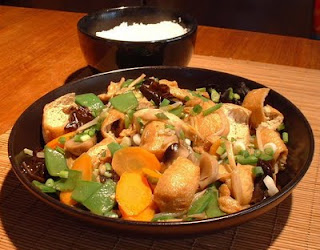Chinese New Year is actually celebrated for 15 days - from the New Moon to the Full Moon. This vegetarian dish is served for breakfast on the first day of the New Year. It was created by the 18 personal disciples of Buddha to avoid starting the New Year by taking a life. At other times of the year, it can be flavored with oysters and oyster sauce to become a rich, filling dish. It has a lot of ingredients, but is not really that much work. Each ingredient has a lucky meaning. We do not use fresh tofu in jai because the white color symbolizes death. But, other than that, there are as many versions of jai as there are cooks who enjoy serving it!
Lo Han Jai (Monk's Food or Buddha's Delight)
(4 servings)
2 c. hot water
2 T. sesame oil
Soak the following in the water, saving the liquid after use. Squeeze excess water from the ingredients back into the pan. The water will be used in making the gravy.
½ c. chin ngee (tree fungus) 1,000 years longevity
¼ c. lin gee (lotus seed) many children
¼ c. bak ko( ginko nuts) 100 grandchildren
½ cup fat choi (black moss seaweed) wealth (sounds like the New Year greeting)
6 gum choi (dry golden lily) gold and good luck
2 foo jook (dried tofu sticks) sounds like "rich enough"
1 bundle jun see (long rice) longevity, beauty, culture
Heat a wok and add the sesame oil. Stir-fry the soaked ingredients lightly, until just heated through. Add the fresh and canned ingredients and stir-fry until heated through.
½ c. sliced bamboo shoots longevity
½ c. sliced lotus root looks like Buddhist symbol - religious diligence 1 carrot, peeled, cut into "coins" red for luck, looks like money
1c. ho lan dow (Chinese peas) sounds like good luck, green color for new growth, peas are round like money
3 leaves bok choi (Chinese cabbage) green of spring
Thoroughly blend the following ingredients:
2 T. Chinese shoyu
1 T. cornstarch
2 tsp. cold water
Add them to the wok and stir quickly until the mix thickens and becomes shiny. Slowly add the soaking water, stirring well. When the gravy is hot and glistening, serve accompanied by freshly cooked rice.
Gung Hee Fat Choy! Happy New Year of the Rabbit 2011!!

"Kaukau" is a pidgin slang word meaning "food" or "to eat." The Hawaiian term for food is `ai. The two theories on the origin of the word "kaukau" are the Hawaiian word for table, pâkaukau, and the Chinese word for food, chow chow. In Hawaii we say "We go kaukau!", I would say, "I hungry I like kaukau!" or "Let's kaukau!" The Cuisine of Hawaii is a fusion of foods brought by immigrants to the Hawaiian Islands, particularly of Portuguese, Chinese, Filipino, Japanese, Korean, Polynesian etc.
Sunday, January 30, 2011
Wednesday, January 05, 2011
Pancit Bihon Recipe
Ingredients:
1 8 oz. pack pancit bihon noodles
1 cooked chicken breast, shredded
1/4 cup frozen or fresh cleaned deveined shrimp
2 cups of chicken broth or 2 chicken bouillon cubes dissolved in 2 cups of water
1/4 cabbage, sliced into strips
1 onion, pealed and sliced
3 cloves of garlic, crushed and minced
1/3 cup scallions, cut into pieces
1 carrot, sliced into strips
2 tablespoons of cooking oil
3/4 cup diced celery
3 tablespoons soy sauce
Salt and pepper to taste
5 pieces of calamansi or 1 lemon, sliced
Cooking Instructions:
Soak the pancit bihon noodles to soften for 10 minutes
Grease a large pan or wok with oil. Sauté garlic and onions. Add shrimp and cook until half pink in color.
Add the chicken broth, the shredded chicken breast and all the vegetables until cooked.
Mix in the pancit bihon noodles and add the soy sauce, cook for about 5 minutes or until the noodles are soft.
Salt and pepper to taste.
Serve hot with sliced calamansi on the side.
Cooking Notes:
Calamansi or lemon is to be squeezed into the pancit bihon before eating.
Subscribe to:
Comments (Atom)











